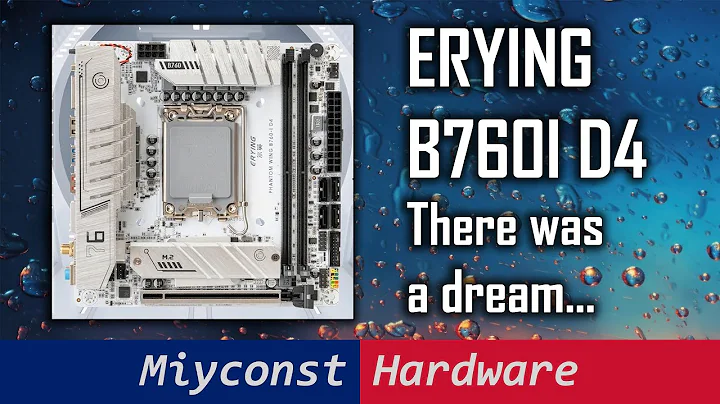How to Replace Thermal Paste on Your Graphics Card
Table of Contents:
- Introduction
- Background
- The Importance of Thermal Paste
- Tools Needed
- Step 1: Removing the Cooler
- Step 2: Cleaning the Card
- Step 3: Applying New Thermal Paste
- Step 4: Reassembling the Card
- Conclusion
Introduction
In this article, we will discuss the process of replacing thermal paste on a graphics card. Over time, thermal paste can degrade and affect the performance of the card. By following a few simple steps, you can improve the cooling efficiency of your GPU and potentially extend its lifespan. We will cover the necessary tools, the step-by-step process, and provide some additional tips for optimal performance. Let's get started!
Background
As technology continues to advance, graphics cards are becoming more and more powerful. With increased power comes increased heat generation. To counteract this, manufacturers apply thermal paste between the GPU (Graphics Processing Unit) and the cooler to improve heat transfer. Over time, however, the thermal paste can dry out and lose its effectiveness, resulting in higher temperatures and reduced performance. Replacing the thermal paste is a maintenance task that can help keep your graphics card running at optimal temperatures.
The Importance of Thermal Paste
Thermal paste plays a crucial role in dissipating heat from the GPU to the cooler. It fills in microscopic imperfections between the two surfaces, reducing the air gaps and maximizing contact for efficient heat transfer. Without proper thermal paste application, heat can build up, leading to thermal throttling, decreased performance, and potentially even permanent damage to the graphics card. Therefore, it is essential to regularly check and replace the thermal paste as needed.
Tools Needed
Before starting the thermal paste replacement process, Gather the necessary tools:
- Screwdriver with Phillips head
- Q-tips
- Rubbing alcohol (91% or higher)
- Thermal paste (non-conductive)
- Cleaning cloth or tissue paper
Having these tools on HAND will ensure a smooth and successful procedure. Now let's dive into the step-by-step process.
Step 1: Removing the Cooler
The first step is to remove the cooler from the graphics card. Most coolers are held in place by screws. Locate the screws on the back of the card and carefully loosen them using the screwdriver. Start by removing the outer screws, followed by the inner ones. Take note of the screws' location for reassembly later on. Once the screws are removed, gently lift off the cooler, keeping it flat to avoid damaging any components.
Step 2: Cleaning the Card
With the cooler removed, it's time to clean the graphics card. Start by using a q-tip and rubbing alcohol to remove any thermal paste residue from the GPU. Be gentle and avoid applying excessive force. Clean both the GPU and the cooler thoroughly, ensuring all old thermal paste is removed.
Step 3: Applying New Thermal Paste
Once the card is clean, it's time to apply new thermal paste. Take a small amount, roughly the size of a rice grain, and apply it evenly on the GPU. Spread the paste using a clean q-tip in a thin layer, ensuring full coverage. Avoid applying too much paste, as it can lead to improper heat transfer. Once applied, double-check for any excess paste and clean it off.
Step 4: Reassembling the Card
With the new thermal paste applied, it's time to reassemble the graphics card. Carefully align the cooler with the screw holes and gently press it down onto the GPU. Begin by tightening the screws in a star pattern, ensuring even pressure. Avoid overtightening, as it can damage the card. Once all the screws are tightened, plug in the fan cables and double-check that everything is securely in place.
Conclusion
Replacing thermal paste on a graphics card is a relatively simple process that can yield significant benefits. By maintaining optimal temperatures, you can improve the performance and lifespan of your GPU. Remember to check your card regularly and replace the thermal paste as needed. Following the step-by-step guide outlined in this article, you can ensure that your graphics card stays cool and performs at its best.
Highlights
- Thermal paste is essential for efficient heat transfer in graphics cards.
- Regularly replacing thermal paste can help maintain optimal temperatures and improve performance.
- Gather the necessary tools: screwdriver, q-tips, rubbing alcohol, thermal paste, cleaning cloth.
- Step 1: Remove the cooler by unscrewing it from the back of the graphics card.
- Step 2: Clean both the GPU and the cooler using q-tips and rubbing alcohol.
- Step 3: Apply a small amount of thermal paste evenly on the GPU and spread it with a q-tip.
- Step 4: Reassemble the graphics card by aligning the cooler and tightening the screws in a star pattern.
- Regularly check and replace the thermal paste to ensure proper heat dissipation.
FAQ
Q: How often should I replace the thermal paste on my graphics card?
A: It is recommended to replace the thermal paste every 1-2 years, depending on usage and temperatures. Regular cleaning and maintenance can help extend the life of your graphics card.
Q: Can I use any thermal paste for my graphics card?
A: It is best to use a high-quality, non-conductive thermal paste specifically designed for computer components. Conductive pastes can cause damage if they come into contact with other components.
Q: Will replacing the thermal paste void my warranty?
A: It depends on the manufacturer and their warranty policy. Some manufacturers allow users to replace the thermal paste without voiding the warranty, while others may consider it a breach of warranty. It is essential to check with the manufacturer before performing any modifications.
Q: Can replacing the thermal paste improve gaming performance?
A: Replacing the thermal paste can help maintain lower temperatures during intense gaming sessions, preventing thermal throttling. While it may not directly increase performance, it can minimize performance drops caused by overheating.
Resources:
 WHY YOU SHOULD CHOOSE TOOLIFY
WHY YOU SHOULD CHOOSE TOOLIFY

























